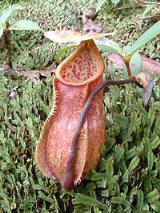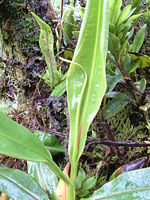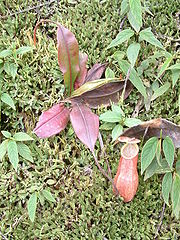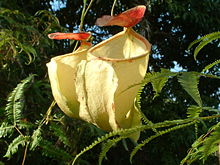
Nepenthes papuana
Encyclopedia
Nepenthes papuana is a tropical pitcher plant
endemic to New Guinea
. The specific epithet papuana is derived from Papua, an alternative name for the island.
 Nepenthes papuana was first collected on October 7, 1909, by Lucien Sophie Albert Marie von Römer. Two plants were collected on this date on a hill below 750 m altitude, in the northern part of the Noordrivier. The species was collected again on January 5, 1913, by Cecil Boden Kloss
Nepenthes papuana was first collected on October 7, 1909, by Lucien Sophie Albert Marie von Römer. Two plants were collected on this date on a hill below 750 m altitude, in the northern part of the Noordrivier. The species was collected again on January 5, 1913, by Cecil Boden Kloss
at an elevation of 920 m, as part of the Wollaston Expedition. Four further collections were made in September, 1926, by Willem Marius Docters van Leeuwen at 250 and 300 m above sea level.
Plant material belonging to N. papuana was first described in 1916 by Henry Nicholas Ridley
. However, Ridley believed it represented a male plant of N. neoguineensis
and did not recognise it as a new species.
B. H. Danser
formally described
N. papuana in his seminal monograph "The Nepenthaceae of the Netherlands Indies
", published in 1928. The description is based on the specimens Docters van Leeuwen 10282, Docters van Leeuwen 10340, and Docters van Leeuwen 10341. The latter two were illustrated in Danser's monograph and consist of male and female floral material, respectively.
s are 2 to 5 cm long. Older plants produce short shoots and rosettes near the base of the stem.
Leaves are sessile or shortly petiolate and coriaceous in texture. The lamina is lanceolate and reaches 30 cm in length and 5 cm in width. It has an acute apex and is attenuate towards the base. Usually around 4 to 6 longitudinal veins are present on either side of the midrib. Pinnate veins are indistinct. Tendril
s are about as long as the lamina and 1 to 2 mm thick.
 Rosette and lower pitchers are obliquely ovate in the lower part and gradually narrowed above, reaching 7 cm in height and 2.5 cm in width. A pair of fringed wings (≤4 mm wide) run down the front of the pitcher. The pitcher mouth is oblique and slightly incurved towards the lid. The peristome
Rosette and lower pitchers are obliquely ovate in the lower part and gradually narrowed above, reaching 7 cm in height and 2.5 cm in width. A pair of fringed wings (≤4 mm wide) run down the front of the pitcher. The pitcher mouth is oblique and slightly incurved towards the lid. The peristome
is 1 to 2 mm wide and bears small teeth. The inner surface of the pitcher is glandular in the lower two-fifths to one-third. The lid or operculum
is suborbicular, slightly cordate, and 1 to 2 cm long and wide. The lower surface of the lid bears no appendages and has many small glands concentrated near the centre. An unbranched spur is inserted at the base of the lid.
Upper pitchers gradually arise from the ends of the tendrils, forming a 6 to 12 mm wide curve. They are shortly infundibular in the lower part, slightly ventricose for around a third of their height, and wholly tubulose in the upper part. Aerial pitchers may be up to 15 cm high and 3 cm wide. Two narrow wings (≤2.5 mm wide) are present over the entire length of the pitcher. They may or may not have fringe elements. The mouth is oblique and acute towards the lid. The flattened peristome is up to 2 mm wide and bears small teeth that are up to twice as long as they are wide. The inner surface of the pitcher is glandular in the ventricose part. The glands occur at a density of 400 to 500 per square centimetre. The lid is nearly round, being only slightly longer than it is wide. It may be up to 3.5 cm long and 3.25 cm wide. Small, depressed glands are present on the undersurface of the lid, being concentrated near the basal part of the midrib. The spur is flattened, 2 to 3 mm long, and unbranched.
Nepenthes papuana has a racemose
inflorescence
. In male plants, the peduncle
is about 6 cm long and 2 mm wide, while in female plants it is 12 cm long and 2.5 mm thick. The rachis
is up to 15 cm long. Pedicels
are up to 15 mm long and do not have a bract
eole. They are almost always one-flowered, although lower ones may be two-flowered. Tepal
s are suborbicular in male plants and oblong in female plants. Stamen
s are 3 to 4 mm long including the anthers. The ovary is sessile. Fruits are 25 to 35 mm long and bear lanceolate valves. The filiform seeds are 12 to 15 mm long.
The indumentum
of N. papuana is generally sparse and short. The stem and lamina are mostly glabrous, except for the midrib, which has caducous brown hairs on its lower surface, and the leaf margin, which bears persistent brown-velvety hairs. Tendrils are similarly hairy to the underside of the midrib. Pitchers have a dense indumentum of short, stellate hairs when young. A sparse covering of these hairs is persistent in lower pitchers, whereas in upper pitchers they are mostly caducous. Developing inflorescences are densely tomentose, becoming more sparsely tomentose when mature.
Lower pitchers are generally reddish throughout with red blotches on their inner surface. Upper pitchers are usually green throughout but may also be reddish. Herbarium specimens are red-brownish, with the upper surface of the leaves being yellow-brownish.
 Nepenthes papuana occurs in the southern part of Western New Guinea
Nepenthes papuana occurs in the southern part of Western New Guinea
, from Fakfak
to Balim valley. The species occurs from sea level to an intermediate elevation of 1300 m.
In its natural habitat, N. papuana grows in exposed sites at forest edges. Lower pitchers frequently develop embedded in moss. The species occurs sympatrically with N. ampullaria
, N. insignis
, N. maxima
, and N. mirabilis
. Despite this, no natural hybrids involving N. papuana have been recorded to date.
Since the full extent of its range is unknown, the conservation status
of N. papuana is listed as Data Deficient
on the 2006 IUCN Red List of Threatened Species
.
 Danser considered N. neoguineensis
Danser considered N. neoguineensis
to be the closest relative of N. papuana. In his description of the species, Danser states: "N. papuana is so much alike N. neoguineensis in its vegetative parts, that only the complete knowledge of the generative parts has suggested me to establish a new species".
The two taxa
can be distinguished on the basis of several morphological features. N. papuana has a racemose
inflorescence, while that of N. neoguineensis is a panicle
or panicle-like raceme. Furthermore, the inflorescence of N. papuana usually bears only one-flowered pedicels
, both in male and female plants. Those of N. neoguineensis can be up to four-flowered.
The lamina of N. papuana has very distinct longitudinal veins and indistinct pinnate veins, whereas in N. neoguineensis the opposite is true. In addition, the leaves of N. papuana are very densely ciliate, much more so than in N. neoguineensis. The wings are less developed in the upper pitchers of N. papuana and the fringe elements are more closely spaced.
Pitcher plant
Pitcher plants are carnivorous plants whose prey-trapping mechanism features a deep cavity filled with liquid known as a pitfall trap. It has been widely assumed that the various sorts of pitfall trap evolved from rolled leaves, with selection pressure favouring more deeply cupped leaves over...
endemic to New Guinea
New Guinea
New Guinea is the world's second largest island, after Greenland, covering a land area of 786,000 km2. Located in the southwest Pacific Ocean, it lies geographically to the east of the Malay Archipelago, with which it is sometimes included as part of a greater Indo-Australian Archipelago...
. The specific epithet papuana is derived from Papua, an alternative name for the island.
Botanical history

Cecil Boden Kloss
Cecil Boden Kloss was an English zoologist. He was an expert on the mammals and birds of Southeast Asia.In the early 1900s Kloss accompanied the American naturalist William Louis Abbott in exploring the Andaman and Nicobar islands. From 1908 he worked under Herbert Christopher Robinson at the...
at an elevation of 920 m, as part of the Wollaston Expedition. Four further collections were made in September, 1926, by Willem Marius Docters van Leeuwen at 250 and 300 m above sea level.
Plant material belonging to N. papuana was first described in 1916 by Henry Nicholas Ridley
Henry Nicholas Ridley
Henry Nicholas Ridley CMG , MA , FRS, FLS, F.R.H.S. was an English botanist and geologist.Born at West Harling Hall, Norfolk, England...
. However, Ridley believed it represented a male plant of N. neoguineensis
Nepenthes neoguineensis
Nepenthes neoguineensis is a tropical pitcher plant native to the island of New Guinea, after which it is named.-Botanical history:Nepenthes neoguineensis was first collected in 1828 by Alexander Zipelius near Triton Bay, New Guinea. Two further collections were made by Gerard Martinus Versteeg on...
and did not recognise it as a new species.
B. H. Danser
B. H. Danser
Benedictus Hubertus Danser , often abbreviated B. H. Danser, was a Dutch taxonomist and botanist...
formally described
Species description
A species description or type description is a formal description of a newly discovered species, usually in the form of a scientific paper. Its purpose is to give a clear description of a new species of organism and explain how it differs from species which have been described previously, or are...
N. papuana in his seminal monograph "The Nepenthaceae of the Netherlands Indies
The Nepenthaceae of the Netherlands Indies
"The Nepenthaceae of the Netherlands Indies" is a seminal monograph by B. H. Danser on the tropical pitcher plants of the Dutch East Indies, North Borneo, the Malay Peninsula, and eastern New Guinea...
", published in 1928. The description is based on the specimens Docters van Leeuwen 10282, Docters van Leeuwen 10340, and Docters van Leeuwen 10341. The latter two were illustrated in Danser's monograph and consist of male and female floral material, respectively.
Description
Nepenthes papuana is a climbing plant. The stem is cylindrical in cross section and 5 to 7 mm thick. InternodePlant stem
A stem is one of two main structural axes of a vascular plant. The stem is normally divided into nodes and internodes, the nodes hold buds which grow into one or more leaves, inflorescence , conifer cones, roots, other stems etc. The internodes distance one node from another...
s are 2 to 5 cm long. Older plants produce short shoots and rosettes near the base of the stem.
Leaves are sessile or shortly petiolate and coriaceous in texture. The lamina is lanceolate and reaches 30 cm in length and 5 cm in width. It has an acute apex and is attenuate towards the base. Usually around 4 to 6 longitudinal veins are present on either side of the midrib. Pinnate veins are indistinct. Tendril
Tendril
In botany, a tendril is a specialized stem, leaf or petiole with a threadlike shape that is used by climbing plants for support, attachment and cellular invasion by parasitic plants, generally by twining around suitable hosts. They do not have a lamina or blade, but they can photosynthesize...
s are about as long as the lamina and 1 to 2 mm thick.

Peristome
The word peristome is derived from the Greek peri, meaning 'around' or 'about', and stoma, 'mouth'. It is a term used to describe various anatomical features that surround an opening to an organ or structure. The term is used in plants and invertebrate animals, such as in describing the shells of...
is 1 to 2 mm wide and bears small teeth. The inner surface of the pitcher is glandular in the lower two-fifths to one-third. The lid or operculum
Operculum (botany)
An operculum, in botany, is a term generally used to describe a structure within a plant, moss, or fungus acting as a cap, flap, or lid. In plants, it may also be called a bud cap.Examples of structures identified as opercula include:...
is suborbicular, slightly cordate, and 1 to 2 cm long and wide. The lower surface of the lid bears no appendages and has many small glands concentrated near the centre. An unbranched spur is inserted at the base of the lid.
Upper pitchers gradually arise from the ends of the tendrils, forming a 6 to 12 mm wide curve. They are shortly infundibular in the lower part, slightly ventricose for around a third of their height, and wholly tubulose in the upper part. Aerial pitchers may be up to 15 cm high and 3 cm wide. Two narrow wings (≤2.5 mm wide) are present over the entire length of the pitcher. They may or may not have fringe elements. The mouth is oblique and acute towards the lid. The flattened peristome is up to 2 mm wide and bears small teeth that are up to twice as long as they are wide. The inner surface of the pitcher is glandular in the ventricose part. The glands occur at a density of 400 to 500 per square centimetre. The lid is nearly round, being only slightly longer than it is wide. It may be up to 3.5 cm long and 3.25 cm wide. Small, depressed glands are present on the undersurface of the lid, being concentrated near the basal part of the midrib. The spur is flattened, 2 to 3 mm long, and unbranched.
Nepenthes papuana has a racemose
Raceme
A raceme is a type of inflorescence that is unbranched and indeterminate and bears pedicellate flowers — flowers having short floral stalks called pedicels — along the axis. In botany, axis means a shoot, in this case one bearing the flowers. In a raceme, the oldest flowers are borne...
inflorescence
Inflorescence
An inflorescence is a group or cluster of flowers arranged on a stem that is composed of a main branch or a complicated arrangement of branches. Strictly, it is the part of the shoot of seed plants where flowers are formed and which is accordingly modified...
. In male plants, the peduncle
Peduncle (botany)
In botany, a peduncle is a stem supporting an inflorescence, or after fecundation, an infructescence.The peduncle is a stem, usually green and without leaves, though sometimes colored or supporting small leaves...
is about 6 cm long and 2 mm wide, while in female plants it is 12 cm long and 2.5 mm thick. The rachis
Rachis
Rachis is a biological term for a main axis or "shaft".-In zoology:In vertebrates a rachis can refer to the series of articulated vertebrae, which encase the spinal cord. In this case the rachis usually form the supporting axis of the body and is then called the spine or vertebral column...
is up to 15 cm long. Pedicels
Pedicel (botany)
A pedicel is a stem that attaches single flowers to the main stem of the inflorescence. It is the branches or stalks that hold each flower in an inflorescence that contains more than one flower....
are up to 15 mm long and do not have a bract
Bract
In botany, a bract is a modified or specialized leaf, especially one associated with a reproductive structure such as a flower, inflorescence axis, or cone scale. Bracts are often different from foliage leaves. They may be smaller, larger, or of a different color, shape, or texture...
eole. They are almost always one-flowered, although lower ones may be two-flowered. Tepal
Tepal
Tepals are elements of the perianth, or outer part of a flower, which include the petals or sepals. The term tepal is more often applied specifically when all segments of the perianth are of similar shape and color, or undifferentiated, which is called perigone...
s are suborbicular in male plants and oblong in female plants. Stamen
Stamen
The stamen is the pollen producing reproductive organ of a flower...
s are 3 to 4 mm long including the anthers. The ovary is sessile. Fruits are 25 to 35 mm long and bear lanceolate valves. The filiform seeds are 12 to 15 mm long.
The indumentum
Indumentum
The indumentum is a covering of fine hairs or bristles on a plant or insect.In plants, the indumentum types are:*pubescent*hirsute*pilose*villous*tomentose*stellate*scabrous*scurfy...
of N. papuana is generally sparse and short. The stem and lamina are mostly glabrous, except for the midrib, which has caducous brown hairs on its lower surface, and the leaf margin, which bears persistent brown-velvety hairs. Tendrils are similarly hairy to the underside of the midrib. Pitchers have a dense indumentum of short, stellate hairs when young. A sparse covering of these hairs is persistent in lower pitchers, whereas in upper pitchers they are mostly caducous. Developing inflorescences are densely tomentose, becoming more sparsely tomentose when mature.
Lower pitchers are generally reddish throughout with red blotches on their inner surface. Upper pitchers are usually green throughout but may also be reddish. Herbarium specimens are red-brownish, with the upper surface of the leaves being yellow-brownish.
Ecology

Western New Guinea
West Papua informally refers to the Indonesian western half of the island of New Guinea and other smaller islands to its west. The region is officially administered as two provinces: Papua and West Papua. The eastern half of New Guinea is Papua New Guinea.The population of approximately 3 million...
, from Fakfak
Fakfak
Fakfak is a city in Indonesia and seat of the Fakfak Regency. It is served by Fakfak Airport. It is the only town in West Papua with a Muslim Indian and Arab Indonesian presence.-History:...
to Balim valley. The species occurs from sea level to an intermediate elevation of 1300 m.
In its natural habitat, N. papuana grows in exposed sites at forest edges. Lower pitchers frequently develop embedded in moss. The species occurs sympatrically with N. ampullaria
Nepenthes ampullaria
Nepenthes ampullaria , the Flask-Shaped Pitcher-Plant, is a very distinctive and widespread species of Nepenthes, present in Borneo, Sumatra, Thailand, Peninsular Malaysia, Singapore, the Maluku Islands, and New Guinea...
, N. insignis
Nepenthes insignis
Nepenthes insignis is a tropical pitcher plant endemic to New Guinea and surrounding islands. The specific epithet insignis is Latin for "distinguished" or "remarkable".-Botanical history:...
, N. maxima
Nepenthes maxima
Nepenthes maxima , the Great Pitcher-Plant, is a carnivorous pitcher plant species of the genus Nepenthes. It has a relatively wide distribution covering Sulawesi, New Guinea, and the Maluku Islands. It is closely related to N. eymae....
, and N. mirabilis
Nepenthes mirabilis
Nepenthes mirabilis , or the Common Swamp Pitcher-Plant, is a tropical carnivorous plant species of the pitfall trap variety. It has by far the widest distribution of any Nepenthes species and is known from the following countries and regions: Borneo, Sumatra, Thailand, Peninsular Malaysia,...
. Despite this, no natural hybrids involving N. papuana have been recorded to date.
Since the full extent of its range is unknown, the conservation status
Conservation status
The conservation status of a group of organisms indicates whether the group is still extant and how likely the group is to become extinct in the near future...
of N. papuana is listed as Data Deficient
Data Deficient
Data Deficient is a category applied by the IUCN, other agencies, and individuals to a species when the available information is not sufficient for a proper assessment of conservation status to be made...
on the 2006 IUCN Red List of Threatened Species
IUCN Red List
The IUCN Red List of Threatened Species , founded in 1963, is the world's most comprehensive inventory of the global conservation status of biological species. The International Union for Conservation of Nature is the world's main authority on the conservation status of species...
.
Related species

Nepenthes neoguineensis
Nepenthes neoguineensis is a tropical pitcher plant native to the island of New Guinea, after which it is named.-Botanical history:Nepenthes neoguineensis was first collected in 1828 by Alexander Zipelius near Triton Bay, New Guinea. Two further collections were made by Gerard Martinus Versteeg on...
to be the closest relative of N. papuana. In his description of the species, Danser states: "N. papuana is so much alike N. neoguineensis in its vegetative parts, that only the complete knowledge of the generative parts has suggested me to establish a new species".
The two taxa
Taxon
|thumb|270px|[[African elephants]] form a widely-accepted taxon, the [[genus]] LoxodontaA taxon is a group of organisms, which a taxonomist adjudges to be a unit. Usually a taxon is given a name and a rank, although neither is a requirement...
can be distinguished on the basis of several morphological features. N. papuana has a racemose
Raceme
A raceme is a type of inflorescence that is unbranched and indeterminate and bears pedicellate flowers — flowers having short floral stalks called pedicels — along the axis. In botany, axis means a shoot, in this case one bearing the flowers. In a raceme, the oldest flowers are borne...
inflorescence, while that of N. neoguineensis is a panicle
Panicle
A panicle is a compound raceme, a loose, much-branched indeterminate inflorescence with pedicellate flowers attached along the secondary branches; in other words, a branched cluster of flowers in which the branches are racemes....
or panicle-like raceme. Furthermore, the inflorescence of N. papuana usually bears only one-flowered pedicels
Pedicel (botany)
A pedicel is a stem that attaches single flowers to the main stem of the inflorescence. It is the branches or stalks that hold each flower in an inflorescence that contains more than one flower....
, both in male and female plants. Those of N. neoguineensis can be up to four-flowered.
The lamina of N. papuana has very distinct longitudinal veins and indistinct pinnate veins, whereas in N. neoguineensis the opposite is true. In addition, the leaves of N. papuana are very densely ciliate, much more so than in N. neoguineensis. The wings are less developed in the upper pitchers of N. papuana and the fringe elements are more closely spaced.
External links
- Danser, B.H. 1928. 34. Nepenthes papuana DANS., nova Spec. In: The Nepenthaceae of the Netherlands IndiesThe Nepenthaceae of the Netherlands Indies"The Nepenthaceae of the Netherlands Indies" is a seminal monograph by B. H. Danser on the tropical pitcher plants of the Dutch East Indies, North Borneo, the Malay Peninsula, and eastern New Guinea...
. Bulletin du Jardin Botanique de Buitenzorg, Série III, 9(3–4): 249–438. - Nepenthes papuana in its natural habitat

